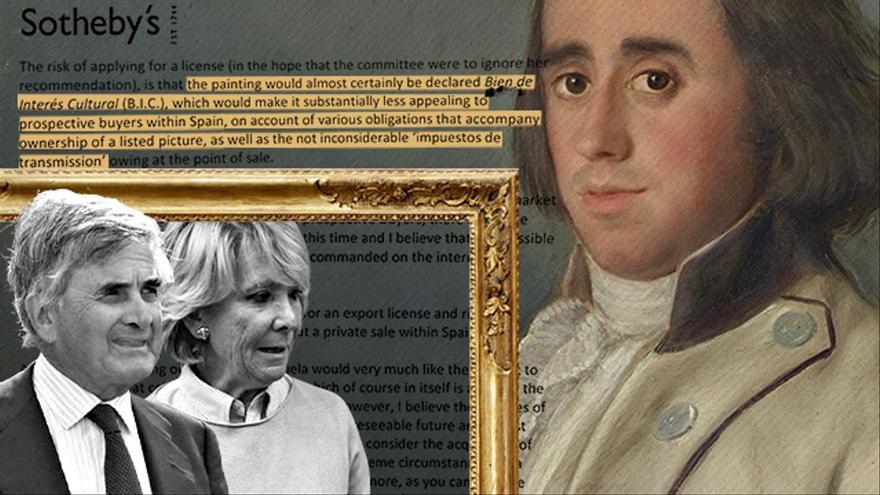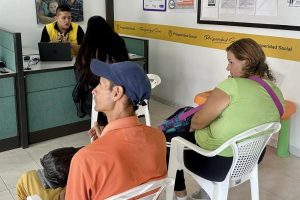The family of Esperanza Aguirre’s husband, Fernando Ramírez de Haro, “schemed” the false donation of a Goya painting so that the couple of the former president of Madrid could sell it and save themselves from financial bankruptcy. In reality, the operation saved the marriage because the marriage lives in a community property regime. The Provincial Court of Madrid confirms it in a 27-page order, in which it makes a detailed tour of the case. Of course, the judges conclude that there was no crime, among other things, because all the brothers of the Ramírez de Haro family gave their agreement to that “invented donation.”
?PODCASTS | The Goya of Esperanza Aguirre
Further
The case was opened as a result of the complaint by Íñigo Ramírez de Haro, Fernando’s brother, who accused him of simulating the donation of the painting, owned by the father of the family, and of not distributing the money he received with his sale. Aguirre and her husband sold the painting to businessman Juan Miguel Villar Mir for 5,115,600 euros when debts with the Treasury threatened to bring Fernando Ramírez de Haro to court. She would have dragged Aguirre, because they are married under a community property regime.
Íñigo maintained in the complaint that his brother Fernando, Aguirre’s husband, deceived him, saying that he would sell the painting on behalf of all the heirs, but that on the death of his mother he would divide its price equally, about 850,000 euros each. one. That deal never happened. The complaint recounts how the simulation of the donation was hatched thanks to the fact that one of the sisters recorded the process in an audio recording, years later.
After two years of judicial process, the Madrid Court definitively closes the case and discards all the crimes that it was investigating for various reasons: that there is a defense of kinship because they are brothers, that there is insufficient evidence, that the Prosecutor’s Office does not appreciate a tax offense or that the documents are not false, they are true even if they originate from an invention agreed upon by all.
But the most relevant thing about the resolution is that it confirms that the donation of the painting from father to son never happened. It was an invention of the family, which formed a “crisis cabinet” to try to save Aguirre and her husband from financial debts.
sister’s confession
The order bases its conclusion on the story he made of Beatriz Ramírez de Haro. He recorded this voice note, to which elDiario.es had access in April 2019, telling his nephews – Aguirre’s children – “a very beautiful story” of the family: how the false donation of the Goya painting was invented when The then president of the Community of Madrid alerted her in-laws that her red numbers were unsustainable.
Beatriz recounts that the family discovered at that time that the painting that had always hung in the family living room was actually the portrait of Valentín Belvís de Moncada y Pizarro, Marquis of Villanueva del Duero, and that it had been painted by Goya, which placed its value between seven and eight million euros. Enough to save Fernando and Aguirre. The family produced a document stating that the painting had been bequeathed by the father only to Fernando, with a false date, and shortly after the couple sold the painting to Villar Mir, a businessman who received millionaire awards from the Community of Madrid during previous years, for more than five million euros.
The analysis of the recording and the comparison of the dates lead the judges to conclude that the Ramírez de Haro family “decided to invent a non-existent donation.” “Beatriz Ramírez de Haro Valdés told the truth to her nephews about such a non-existent donation,” the order insists at various times, detailing how the family “crisis cabinet” to save Aguirre and her husband devised that strategy and prepared some documents fake.
An “ideological falsification”
However, in the lengthy review of the facts, the judges stop at each reported crime to rule it out. For example, that of the documentary falsehood of the invented donation. The Provincial Court points out that there is an “ideological falsehood”, but that the documents are “genuine and authentic”. That is, they are made under a false premise, but their preparation is authentic and they are signed by a notary. Ideological falsification, they say, can only be committed by authorities and officials, “a condition that Mr. Fernando Ramírez de Haro Valdés lacks.”
The order also emphasizes that the invention process was endorsed by the complainant: “Íñigo Ramírez de Haro Valdés showed his agreement, demanded to document such a figurative donation in order for Mr. Fernando Ramírez de Haro Valdés to have a property title over the work that would allow him to sell it to third parties”.
The plaintiff’s defense argues that Íñigo wanted to help his brother and signed what Fernando’s notary put in front of him – without giving him a copy, nor showing him the simulated deeds of 2012 about the non-existent donation, they add. When he realized the manipulation, he sued and included the notary.
Aguirre’s maneuvers
The judges ruled out the tax crimes denounced by Íñigo and also the corporate crimes related to the management of family businesses, the latter due to the family relationship between the brothers, which prevents Íñigo from accusing Fernando, as established by Spanish law.
The car reviews some of Aguirre’s maneuvers, but also frees the former regional president from any criminal reproach. For example, the reduction from the Community of Madrid of 95% of the inheritance tax three days before her husband’s father died.
The judges see only “a coincidence of dates” and rule out that the Aguirre government sought to modify a tax “especially for the benefit” of her husband. “The reality is that the legislative amendment benefited a plurality of heirs,” they conclude.
Nor do they see a crime in that Aguirre sold the Goya to Villar Mir, with whom he had a friendly relationship; that is to say, that the businessman had helped the couple in the commission of a crime by buying the painting that he had obtained through a false donation: “Since the commission of the crime is derived from friendship, it is conjecture.”
The beautiful family story that Beatriz Ramírez de Haro told her nephews in April 2019 thus adds a new chapter: justice confirms that everything was a farce, but concludes that there was no crime.
–––––
The value of journalism
elDiario.es is financed by the contributions of 60,000 members who support us. Thanks to them, we can write articles like this one and that all readers – including those who cannot pay – have access to our information. But we ask you to think for a moment about our situation. Unlike other media, we do not shut down our journalism. And that makes it much more difficult for us than for other media to convince readers of the need to pay.
If you get information from elDiario.es and you believe that our journalism is important, and that it is worthwhile for it to exist and reach as many people as possible, support us. Because our work is necessary, and because elDiario.es needs it. Become a member, become a member, of elDiario.es.











